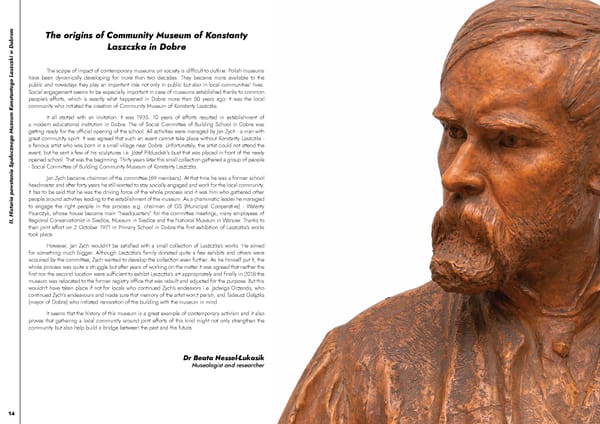em The origins of Community Museum of Konstanty Laszczka in Dobre czki w Dobr The scope of impact of contemporary museums on society is difficult to outline. Polish museums have been dynamically developing for more than two decades. They became more available to the public and nowadays they play an important role not only in public but also in local communities’ lives. Social engagement seems to be especially important in case of museums established thanks to common onstantego Laszpeople’s efforts, which is exactly what happened in Dobre more than 50 years ago. It was the local community who initiated the creation of Community Museum of Konstanty Laszczka. eum K It all started with an invitation. It was 1935. 10 years of efforts resulted in establishment of a modern educational institution in Dobre. The of Social Committee of Building School in Dobre was getting ready for the official opening of the school. All activities were managed by Jan Zych - a man with great community spirit. It was agreed that such an event cannot take place without Konstanty Laszczka - a famous artist who was born in a small village near Dobre. Unfortunately, the artist could not attend the event, but he sent a few of his sculptures i.a. Józef Piłdusdski’s bust that was placed in front of the newly opened school. That was the beginning. Thirty years later this small collection gathered a group of people - Social Committee of Building Community Museum of Konstanty Laszczka. Jan Zych became chairman of the committee (69 members). At that time he was a former school wstania Społecznego Muzheadmaster and after forty years he still wanted to stay socially engaged and work for the local community. It has to be said that he was the driving force of the whole process and it was him who gathered other people around activities leading to the establishment of the museum. As a charismatic leader he managed to engage the right people in the process e.g. chairman of GS (Municipal Cooperative) - Walenty Pisarczyk, whose house became main “headquarters” for the committee meetings, many employees of II. Historia poRegional Conservationist in Siedlce, Museum in Siedlce and the National Museum in Warsaw. Thanks to their joint effort on 2 October 1971 in Primary School in Dobre the first exhibition of Laszczka’s works took place. However, Jan Zych wouldn’t be satisfied with a small collection of Laszczka’s works. He aimed for something much bigger. Although Laszczka’s family donated quite a few exhibits and others were acquired by the committee, Zych wanted to develop the collection even further. As he himself put it, the whole process was quite a struggle but after years of working on the matter it was agreed that neither the first nor the second location were sufficient to exhibit Laszczka’s art appropriately and finally in 2018 the museum was relocated to the former registry office that was rebuilt and adjusted for the purpose. But this wouldn’t have taken place if not for locals who continued Zych’s endeavors i.e. Jadwiga Grzenda, who continued Zych’s endeavours and made sure that memory of the artist won;t perish, and Tadeusz Gałązka (mayor of Dobre) who initiated renovation of the building with the museum in mind. It seems that the history of this museum is a great example of contemporary activism and it also proves that gathering a local community around joint efforts of this kind might not only strengthen the community but also help build a bridge between the past and the future. Dr Beata Nessel-Łukasik Museologist and researcher 14 15
 "Gdzie Laszczka tam Bóg..." Page 8 Page 10
"Gdzie Laszczka tam Bóg..." Page 8 Page 10